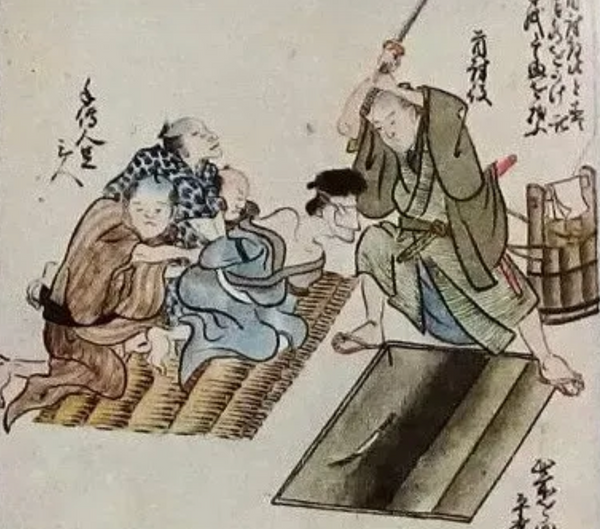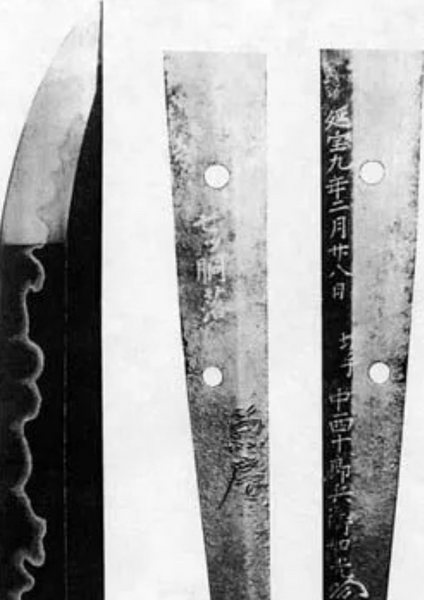How Sharp Are Katanas?
Table of Content
- How Sharp Are Katanas?
- Understanding The Sharpness Of Your Katana
- Role Of Material And Forging In The Sharpness Of A Katana
- Tameshigiri- The Ancient Art of Testing Katanas
How Sharp Are Katanas?
The sharpness of Katanas is mythic. You probably remember a scene or two from Samurai movies where shocked villains find themselves sliced in half in the blink of an eye. But are Katanas actually that sharp? Per historical inscriptions, ancient Katanas did have that kind of edge.
Katana is sharp enough to slashing through multiple human bodies in one swing. Tameshigiri practitioners literally sliced through cadavers or live convicts to test and establish authenticity. However, the modern practice of testing sharpness is less morbid. You have a sharp katana if it can slice paper.
Modern Tameshigiri practitioners use Tatami Mats instead of human bodies. Although, these mats, made of woven straw, provide the same consistency. Tameshigiri itself is an excellent form of martial to enhance your body and mind. Learn more about exactly how sharp are katanas and the legendary practice of testing blades.

Understanding The Sharpness Of Your Katana
To retain the sharp edge of your Katana, you must understand the determiners of the sharpness. Two factors influence the sharpness of this sword- the edge angle and the steel's hardness.
Katana blades are curved. Therefore, the blade's two sides form an angle at the tip. This is the edge angle. Meanwhile, hardness refers to the sword's ability to withstand impact. The harder it is, the more it can survive deformation.
Thin Katana
You need a thin blade if you want an extraordinarily sharp katana that can cut through paper or silk in mid-air. Such a blade shall have an acute edge angle and minimal hardness.
The light weight allows the warrior to focus more on speed and precision. They don't have to worry much about moving a heavy blade. However, a thin katana also means a brittle edge. Since it's not hard, it can quickly get indents when hitting thicker targets.
Thick Katana
In comparison, a thicker katana with an obtuse angle won't be as efficient in slicing through thin objects. However, it has superior hardness.
Therefore, a thicker, heavier katana with a less sharp edge is better at withstanding impact. It doesn't easily break off and retains its sharpness for longer.
To understand this phenomenon, consider the example of an axe. An axe has a thick edge. You cannot slice through paper with it. But it's ideal for chopping thick wood. Similarly, a razor blade can cut paper. However, you will ruin a razor if you try to chop wood with it.
Role Of Material And Forging In The Sharpness Of A Katana
Material, forging, and polishing techniques are especially important when it comes to Katana's sharpness.
The legendary sharpness and quality of ancient Japanese Katanas have much to do with these factors. Modern-day Katanas do not use ancient techniques- which might be why they lack historic qualities.
Modern-Day Material and Technique
These days manufacturers use T10 and S7 steel to forge the swords. These materials have superior hardness and are ideal for making sharp, long-lasting blades.
The T10 steel contains high carbon and tungsten. Meanwhile, S7 steel has high levels of chromium and molybdenum. The nature of these materials makes the Katana resistant to shock and wear.
Other types of steel are also used to make these swords. However, manufacturers always prefer high-carbon steel to low-carbon due to its durability. The problem is high carbon steel tends to chip and crack.
To prevent that, makers utilize “Differential Hardening" when forging high-carbon steel Katanas. During this hardening process, the make heats and cools the different parts of the blade at different rates.
The result is a blade with a softer spine and harder edge. The soft spine can easily absorb shocks. Meanwhile, the hard edge can retain its sharpness after numerous practice sessions.
Differential hardening creates a pattern on the blade knowns as 'Hamon.' It indicates the transition of the harder edge to the softer spine.
Tamahagane: The Ancient Material of Forging Katanas
The legendary katanas in ancient Japan were forged from Tamahagane. It translates to 'Jade Steel.' The meaning of the name gives you a clue on how superior this steel was from average material.
Tamahagane was extremely rare and precious even in those days. The swordsmiths used a special kind of clay furnace to create this metal. This special furnace is known as 'Tatara'. The makers would smelt iron sand in this furnace to make Tamahagane.
This mythic material was essentially high-carbon steel. As a result, Katanas made from Tamahagane were powerful and durable.
Since it was high-carbon steel, the material was vulnerable to chipping. It also had various kinds of impurities, which made the blade uneven.
So, swordsmiths used special forging techniques to create a pure and balanced product. This technique involved repeated hammering of the Tamahagane.
During these sessions, the swordsmith would fold the steel again and again. As a result, a single blade comprised numerous layers of steel.
The unique forging process removed the various impurities in the material. It also ensured that the carbon content distributes evenly in the sword. The result was a strong and flexible blade.
An important part of this forging process was the application of clay on various areas of the blade. Afterwards, the swordsmith would dip it in water. This created soft and hard zones in the blade, which improved its resilience and performance.
Tameshigiri- The Ancient Art of Testing Katanas

So how do you know for sure your Katana can hold its own in battle? Ancient warriors had the same concern. You can't walk into a battle without knowing precisely how capable your weapon is.
The solution was- Tameshigiri. It literally translates to 'Test Cutting'. Apart from testing sharpness, Tameshigiri also provides decent exercise for warriors.
Ancient Tameshigiri
The practice of Test Cutting started in Japan's Edo Period. That was approximately four hundred years ago today.
It is important to note that Katana makers did not perform Tameshigiri themselves. They had the skills to forge blades but not to wield them. So, they handed over their finished products to Samurais, who carried out the test cutting.
Back in those days, Samurai used a variety of materials to test the katanas. Rice Straw, bamboo, and woven rush mats were common targets. Samurais also cut through thin steel sheets to test the blade's authenticity.
Samurai also use human bodies to ensure the performance of Katanas in actual battle. They used cadavers and sometimes alive human beings who had been convicted.
The samurai tested the swords by performing a variety of cuts, such as diagonal slashing from shoulder to opposite hip, ankle cut, hip cut, etc. They also sliced human heads from a variety of angles.
Afterwards, they would engrave their findings on the Nakago (tang of the katana). For instance, there might be an inscription (Mei) on the sword's tang that says '3 bodies with Tabi-gata'. It meant you could slice through three human bodies using an ankle cut with one swing of this sword. This kind of inscription is called Saidanmei.
These tests and subsequent inscriptions were extremely important in determining the value of Katanas.
The more bodies it could cut from strategic angles, the more money someone would pay for it. Plus, it would increase the confidence and success of the katana wielder in battles. Katanas distinguished by their exceptional sharpness were categorized as "Wazamono (業物)." Based upon their performance in tameshigiri, the art of test cutting, swordsmiths were systematically classified into four distinct ranks:
Saijō Ōwazamono (最上大業物, Supreme Grade Wazamono): This premier tier comprises 15 master smiths renowned for forging swords of unparalleled sharpness.
Ōwazamono (大業物, Great Wazamono): The second-highest rank, encompassing 21 smiths noted for their high-quality craftsmanship.
Ryōwazamono (良業物, Good Wazamono): The third tier includes 58 smiths recognized for producing swords of commendable sharpness.
Wazamono (業物, Wazamono): The fourth category consists of 93 smiths known for crafting swords with respectable sharpness.
Additionally, 68 swordsmiths, proficient in various grades of Wazamono craftsmanship, are also acknowledged, culminating in a total of 255 smiths celebrated for their expertise in forging and sharpen katana.

*A Katana with 7 bodies cut record
Tameshigiri isn't limited to testing the sword's sharpness. Instead, it was also a test for the performing Samurai himself. The ability to make precise cuts would attest to the warrior's skills and experience.
There was a spiritual element to Tameshigiri. Samurai considered the practice to be a way of honouring the spirit of the Katana and its maker.
Modern Tameshigiri
These days Tameshigiri is more than just a method of testing Katanas. It is a separate form of martial arts itself.
A Tameshigiri practitioner develops, practices, and demonstrates their skills of sword-wielding. It takes a lot of discipline and focus to master and perform the various Tameshigiri cuts.
Human bodies are no longer used for testing swords. Instead, Goza and Tatami are the material of choice for the modern samurai, you can diy your own tameshigiri material for practice.
They soak the mats in water and roll them up tightly. Tameshigiri practitioners might sometimes insert bamboo or wood in the rolls to increase the difficulty. They arrange the targets in various ways- vertically, horizontally, or at an angle. For beginner, a 45 degree angle cut is usually the best for beginner.
Modern Tameshigiri has a whole library of well-defined cuts. Examples include downward diagonal, upward diagonal, straight downward, etc. The technique and requirements (power and speed) of each cut vary slightly from each other.
Kendo, Kenjutsu, Battodo, and other martial arts centred around sword skills incorporates Tameshigiri in their training.
Since you are making contact with a target, Tameshigiri tells you how efficient you will be with a katana in a real battle. It tests your grip, sense of distance, and ability to utilize the blade angle.
It also teaches you proper core engagement when swinging the sword. Therefore, your hits become faster and more powerful. Plus, the core strength translates to better performance in your regular martial arts session.
Conclusion
So, how sharp are katans? Katanas are some of the sharpest blades humans have ever made. Although they are no longer used to fight battles, swords are still an important element of martial arts.
You must regularly polish, oil, and sharpen your Katana to retain its paper-slicing edge. And lastly, always be careful when you are wielding these blades.





















